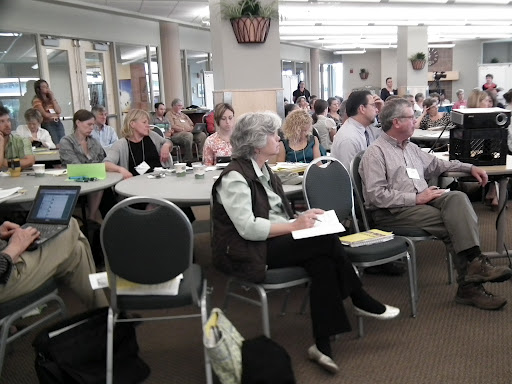What happens when you put 100 New England food leaders in a room together for a day to consider a common vision? Lots of smart people with great ideas and questions build important bonds and agree to keep talking.
This is what happened at the University of Vermont on June 28-29, 2012, when invited guests from across the region gathered to discuss the Good Food Vision and imagine what benefits would arise from deeper connections and common plans. The event, co-hosted by the University of Vermont and Food Solutions New England (University of New Hampshire), was the second annual meeting with this emphasis. Conveners predict that strengthening collaborations will help to advance a sustainable regional food system.
At the heart of the agenda was review of the bold vision which proposes that the New England region produce, market and consume 80% of its own food by 2060 in a way that is healthy, fair, green and affordable. This four-part definition of “good food” was taken from the Kellogg Foundation which has a program dedicated to strengthening food in communities. Brian Donahue, lead author of New England’s Good Food vision, presented its key points and then sought input from other leaders at the summit.
There was no shortage of dialogue from this engaged group! One of the first comments was a clarification about the term “good food.” A farmer participant wondered if he or other farmers might be growing “bad food,” and thought that the term “good food” would be off-putting for some. Others questioned particular aspects of the vision, such as the likelihood of meeting the 2060 aspiration, and how the vision was going to enhance food security. In general, participants were on board with the vision, but thought it needed some further fleshing out.
Organizers recognized the value of having summit participants gather by state to consider alignment within each state, and the benefits of working regionally. Following these gatherings, state-by-state report-outs showed the variability in progress of food system planning at the statewide level, with Vermont being the furthest along. There was general agreement that development of mutual metrics and data sharing would be positive. However, when one participant questioned whether the six New England states provided the correct boundaries for a “region,” it became clear that there are a range of options. Should New York and southern Quebec be considered part of this region, and included in future meetings? No decisions were made.
Following an afternoon keynote by Rich Pirog (Michigan State University), examples of current New England regional projects were shared. Peter Allison talked about Farm to Institution in New England (FINE), Ellen Kahler of the Vermont Sustainable Jobs Fund described the Vermont Atlas tool, Kathy Ruhf reviewed the work of the Northeast Sustainable Agriculture Working Group (NESAWG), Chris Coffin from American Farmland Trust talked about their work with the state land commissions, and Steve Revitsky of Connecticut represented the region’s Commissioners of Agriculture.
Despite the absence of a concrete commitment to the Good Food vision, participants left the summit in general agreement that working together will help us all move forward.












